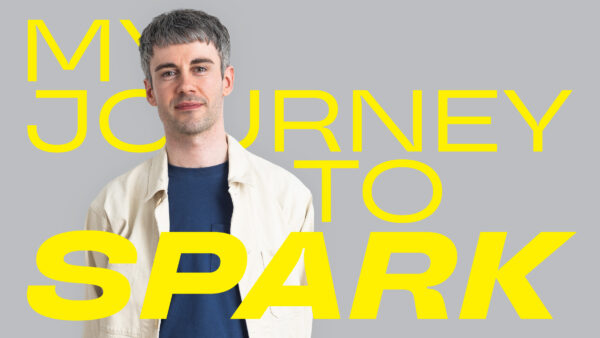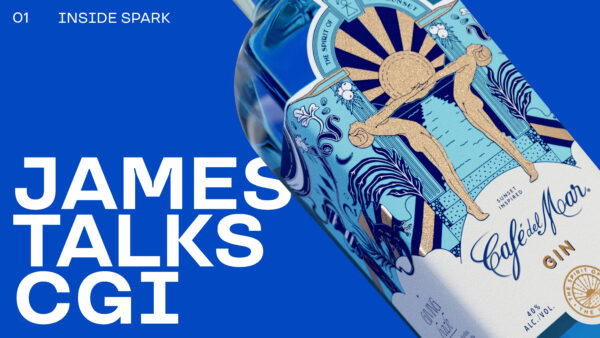
Inside Spark: CGI

This month, we invite James, from Spark’s dedicated CGI studio Coolbreed to talk trends, working smart and the dark side of CGI.
Welcome, James!
The CGI industry is developing at a pace and it’s really fascinating to watch! Can you start by sharing some examples of Brands are using CGI well?
Toblerone used CGI to showcase their new product. They used amazing storytelling with eye-catching visuals to make the viewer feel like they were experiencing exactly how the new product was made. With the help of voice-over and sound effects, this video was a stand-out when I first saw it. And the small details like the slightly waxy surface of the chocolate works so well.
https://www.youtube.com/watch?v=ko2pEjODc-o
Marks & Spencer created several CGI videos for their social media pages to promote their bra campaign. They followed the trend of 3D tracking and their videos had the product hanging from Tower Bridge. It was a fun and creative way to showcase their message which stood out and compared well with the brands traditional social content. Having done a number of these now ourselves there are some very slight tricks used to create realism and carry the concept like the subtle swinging of the bra.
https://www.instagram.com/reel/C3Z4AFOqTf3/
We’re loving these examples, James!
A topic that we get asked about often is Photography vs. CGI. We’re a big fan of photography, but can you share your view on when you’d recommend a CGI approach over the former?
You would think that 3D is useful for hyper-real or surreal applications but it is not the case. It can be used to keep the budget low and avoid tricky logistics. And once a model has been created and lighting is honed it’s much cheaper and quicker to roll out more assets or fix a “shoot”.
All the same things are covered as in a photo or video shoot including art direction, lighting, and styling with props selection etc.
CGI should be used when photography cannot capture particular essential visual requirements. For instance if a client requires custom environments or a rotating product, it will be easier to use CGI software to create it.
The flexibility of CGI is unmatched when compared to photography. Being a CGI artist, I am always in full control of everything at any given moment. From the lighting, textures or composition and colours. Compared to photography where reshoots could take many hours, CGI requires just a movement of the cursor and the click of a few buttons.
I think the biggest comparison can be time and cost. Our clients are often surprised at how cost effective it can be, especially if a piece of work requires regular updates. Additionally, CGI is used over photography because the process can be quicker and more straightforward. A photoshoot could take days to plan and organise with the possibility of weather issues. However, CGI requires one individual with a computer.
And let’s address the darker side of CGI, what are your thoughts on the ethical challenges it’s seeing, and how would you advise clients to navigate this?
We have all seen AI bleed into our workflows and disciplines and 3D is the same. Various ethical challenges occur within CGI technology, such as misinformation and manipulation. One that I have seen which can be twisted from real to fabricated is ‘deepfake’ technology. Some may say it is a bit of fun to manipulate images or voices but in my opinion this is unethical if this involves the use of private content for the enhancement of another persons goals.
It is very easy to use CGI to advertise body figures. Showcasing beauty to a level that is unrealistic can cause insecurities. I think clients have a responsibility to be more transparent and understand the impact they can have.
Can you also tell us about the way that Creative Spark clients are typically using CGI?
The market for CGI services is huge. Almost all industries have the need for CGI in one way or another, for items such as product visuals, storytelling animation and immersive experiences. Here’s a few examples of how our clients are using CGI:
A popular use of CGI is for attractive visuals for social media. It sounds straightforward, and it is, but it also works! The Cafe Del Mar campaign was to re-create their gin and vodka bottles in CGI and to focus on their characteristic artistic labels and materials. This is one of my favourite projects because it’s straight to the point and looks great! And with us working with a client overseas we could both feed in on the project remotely which was a huge help.
https://creativespark.co.uk/work/cafe-del-mar/
CGI can be used to demonstrate a walk-through of the product on rotation, and even its inner workings that wouldn’t be possible through film. It can even be used to showcase a variety of customisations, allowing customers to play with different add-ons to find the best solutions.
An example of how we used this approach was with our client Reisser, to demonstrate the range of features for the Create Mate. We created a symphony of curated movement, if this were done with a camera it would be very difficult or expensive needing specialist camera equipment.
https://creativespark.co.uk/work/reisser-crate-mate/
We’re seeing a rising popularity of this trend, brands essentially create 3D products and composite in real world footage. Typically, this is being used to create PR buzz at launch or exemplify a particular product benefit or feature. This concept was the perfect solution for our client Catapult when they launched their biggest ever printer. We used a larger than life printed reel wrapped around US landmarks to tell their new product story. Engaging, eye-catching and unique. We used subtle tricks like camera shake and light and shadow to really carry the concept.
https://creativespark.co.uk/work/catapult-26-press-campaign/
And for those new to the world of CGI, what advice would you give before getting started on briefing their agency?
The most important is don’t be afraid to ask as many questions when discussing a brief, that’s what it’s there for. The more questions you ask the better will be your understanding of the requirements and the successful delivery of the final product. But here are some pointers to consider before you get started.
Thanks James! What made you choose the CGI career path, ‘Why CGI’?
I do what I do because CGI offers a high level of creative freedom and makes my ideas come to life. The CGI industry is constantly evolving to allow designers to produce even more striking work and means I am fully engaged in continuous improvement.
Overall, I would say being a CGI artist is much more than a job. It allows me to fulfil my creative passions.
Finally, who are Coolbreed?
Coolbreed was born from a need to make 3D more affordable. As the dedicated Creative Spark CGI department. They specialize in 3D product visualizations, providing services for clients in manufacturing, F&B, and beyond. Coolbreed helps to replace photography and video when these options are not viable, reducing costs and increasing engagement.
MAKING THE UNREAL REAL.
Thanks for reading, we hope this has been a useful insight into the opportunities that CGI could unlock for your brand. If you have any questions, do not hesitate to get in touch at [email protected]